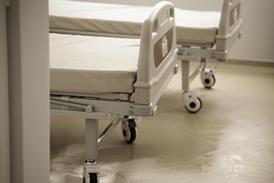From 5 to 8 December 1952 smog (fog filled with smoke) of unusual density and persistence covered the Greater London area.
People piled coal onto their fires to keep warm. To most, smog was no more than an inconvenience. Those with chronic heart and lung disease were less lucky. Their illnesses got worse and many died. Dying people, their lips blue from lack of oxygen, were forced to walk to the hospital for ambulances had stopped running.
For some years an emergency bed service had operated in London, finding beds for emergency admissions by phoning round the hospitals. It came under pressure and immediately restricted non-urgent admissions, but the media were first to spot the severity of the problem.
Florists ran out of flowers for funerals.
Newspaper articles drew attention to the death of prize cattle at the Smithfield show.
Not until the death certificates had been assembled was the full severity of the episode apparent: there were 3,500-4,000 excess deaths.
St George’s (Hyde Park Corner), like all London hospitals, admitted many victims of bronchitis and heart failure; as it was not possible to see from one end of a ward to the other, they were divided in two so that patients could be properly observed.
A committee under the chairmanship of Sir Hugh Beaver was set up, which rapidly identified the importance of pollution from solid fuels. Its recommendations formed the basis of the Clean Air Act 1956. Emission control was required; industry had to change and methods of manufacturing had to alter. It became an offence to emit dark smoke from a chimney and local authorities were able to establish smoke control areas.
Following the legislation, the age-specific death rates of men in Greater London fell by almost half. The opposition to the control of atmospheric pollution, for example from industry, was slight.
A major advance in public health had taken place and similar legislation was passed in other countries.
























No comments yet